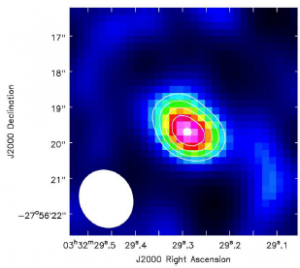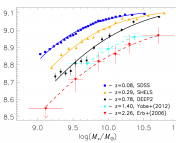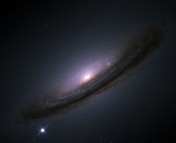- Title: ALMA reveals a chemically evolved submillimeter galaxy at z=4.76
- Authors: Tohru Nagao, Roberto Maiolino, Carlos De Breuck, Paola Caselli, Bunyo Hatsukade, Kazuya Saigo
- First author’s institution: Kyoto University, Japan
How to detect light from a very distant galaxy:
The metals in a galaxy tell a lot about its history, because these metals have been processed as the stars formed, evolved, and died (here ”metals” means anything other than H and He). To date, the metal content of galaxies has been investigated for several galaxies up to a redshift of about 3 (looking at the Universe as it was about 11 Giga-years ago — you can convert redshift to time or distance here). For these (somewhat) neighbors of ours, the metallicity can be determined by observing optical emission lines that are shifted via the Doppler effect and detected at infrared (IR) wavelengths. But for more distant galaxies these lines are red-shifted out of the atmospheric window at IR wavelengths, i.e. their wavelengths are stretched so much that we can’t detect them with IR instruments. Making matters more difficult, the youngest galaxies with very active star formation often reside in dusty regions (conducive for star formation), obscuring the optical radiation and possibly biasing the metallicity measures for these galaxies.
But, the quest goes on, to determine the metallicities of galaxies even more distant and even earlier in the Universe — Nagao et al. are hunting for light from a galaxy at z=4.76 (more than 12 Gyrs ago)! The trick is to detect the light with wavelengths that have been red-shifted so much that the radiation is detectable with millimeter- and sub-millimeter telescopes. Now, if you need a refresher on Doppler red shifts as they pertain to cosmology, let’s take [N II] (an emission line from singly-ionized nitrogen gas), which emits light at 205 microns (that’s 205/1,000,000 meters). Redshift can be defined as z = Δλ / λ, or you can determine the amount that a wavelength is stretched using the relation 1+z = λ(observed) / λ(emitted). Hence, the [N II] line is emitted with a wavelength of 205 microns, but coming from a galaxy at redshift 4.76, we detect (here on earth) light with wavelength 0.1 millimeters (just 1/1000 meters). This wavelength corresponds to a frequency of 254 GHz, which is perfectly in the range of the ALMA detector!

Figure 1 from Nagao et al. shows what the galaxy LESS J0332 looks like to ALMA, detecting nitrogen emission that was emitted with a wavelength of 205 microns and observed (due to red-shift) with a wavelength of about 1 millimeter. The image might not tell you much, but the authors use the wavelength of light that was detected to determine that this galaxy has a red-shift of z~4.76, and that the ratio of ionized nitrogen to carbon is similar to the ratio in nearby galaxies.
The Observations:
These authors chose to observe the [N II] emission line, which generally arises from dense gaseous regions called HII regions (regions of ionized hydrogen gas associated with young, massive star clusters). For the same galaxy, the authors had previously observed [C II] emission line, which comes from both HII regions AND photodissociation regions (neutral regions found at the boundaries of giant molecular clouds). The ratio of these lines, [N II]/[C II], depends on gas density and other gas properties of the galaxy, and specifically it is related to the amount of metals in the galaxy.
As explained above, for a galaxy with z=4.76, the [N II] 205 micron emission line is red-shifted to ~0.1 millimeters, or 254 GHz. The authors put the new ALMA observatory to use to observe this line for the galaxy called LESS J0332 (this is a galaxy previously observed as part of the survey called LESS using the APEX telescope in northern Chile, near ALMA), with data obtained using a total of about 4 hours observing time and 18 antennas comprising the interferometer (a note: ALMA is currently operating in “Early Science” mode. But, with just a fraction of its eventual 66 antennas, it is already the largest interferometer in the world. Also, check out these previous astrobites with more ALMA Early Science.).

Figured 2 from Nagao et al. The flux density on the y-axis represents the intensity of light detected at each wavelength, which has been translated into velocity (lower x-axis) and redshift (upper axis). This paper presents observations with ALMA of N II, and compares with previous observations of C II with APEX and CO with ATCA. They find a redshift of 4.76 (the peak of the best-fit gaussian profile in red).
The Results:
First, it’s important to note that the authors didn’t know, to begin with, the exact distance to this galaxy (in the sense that they couldn’t go out there with a ruler and make their measurements prior to these observations). They had to base their estimates on previous studies. One result of their current observations is to confirm the redshift (or distance) to the galaxy based on the wavelength of [N II] emission that they detected. Based on the rest wavelength of [N II] emission which is 205 microns, and the detected wavelength of 1.12 millimeters, they infer a redshift of 4.7555, in agreement with some — but not all (see the figure to the left) — previous observations of this galaxy. For example, this galaxy was observed by the same group (see De Breuck et al. 2011), but detecting emission from the [C II] 158 micron line, and they found a redshift z=4.7534. One explanation might be that the system is not chemically homogeneous; in other words, the distribution of metals varies throughout.
The unique component of this study, for this galaxy, is that the authors present the ratio of [N II]/[C II]. Whereas previous measurements have been made for one or the other of these lines in distant galaxies, this is the first study that makes both. They measure a ratio [N II]/[C II]=0.043. In the nearby universe, the value of this ratio has been found to be ~0.02-0.07, and hence this distant galaxy fits right in. Remember that this ratio gives information about gas properties, and specifically relative metal content of a galaxy. The authors determine that the metallicity of this galaxy is similar to the metallicity of our Sun, suggesting that the chemical evolution has progressed very rapidly in this system, considering how young it is compared with our Sun.
Conclusions:
This paper presents the first ever measurement of both [N II] and [C II] for the galaxy LESS J0332, which is determined to be at a redshift of 4.76 and have a metallicity similar to that of our sun. LESS J0332 is considered a “sub-millimeter galaxy”, because we detect its light at sub-mm wavelengths here on earth, but in fact it is emitting very intense radiation at near-infrared wavelengths (for example, several hundred microns in the case of [N II] and [C II]) that has been red-shifted to the sub-mm wavelengths which we detect. This type of galaxy is very common at high redshifts, and so in order to understand the dominant sources of emission at early epochs of the Universe, it is very important to observe these galaxies.
More specifically, the ratio of [N II]/[C II] = 0.043 for this galaxy is similar to the ratio found for local galaxies, meaning that the production and churning of chemicals must have happened very early in the universe, and since then has remained relatively constant for most galaxies. In related works that consider possible galaxy formation and evolution mechanisms, studies like today’s by Nagao et al. must be taken into consideration.




